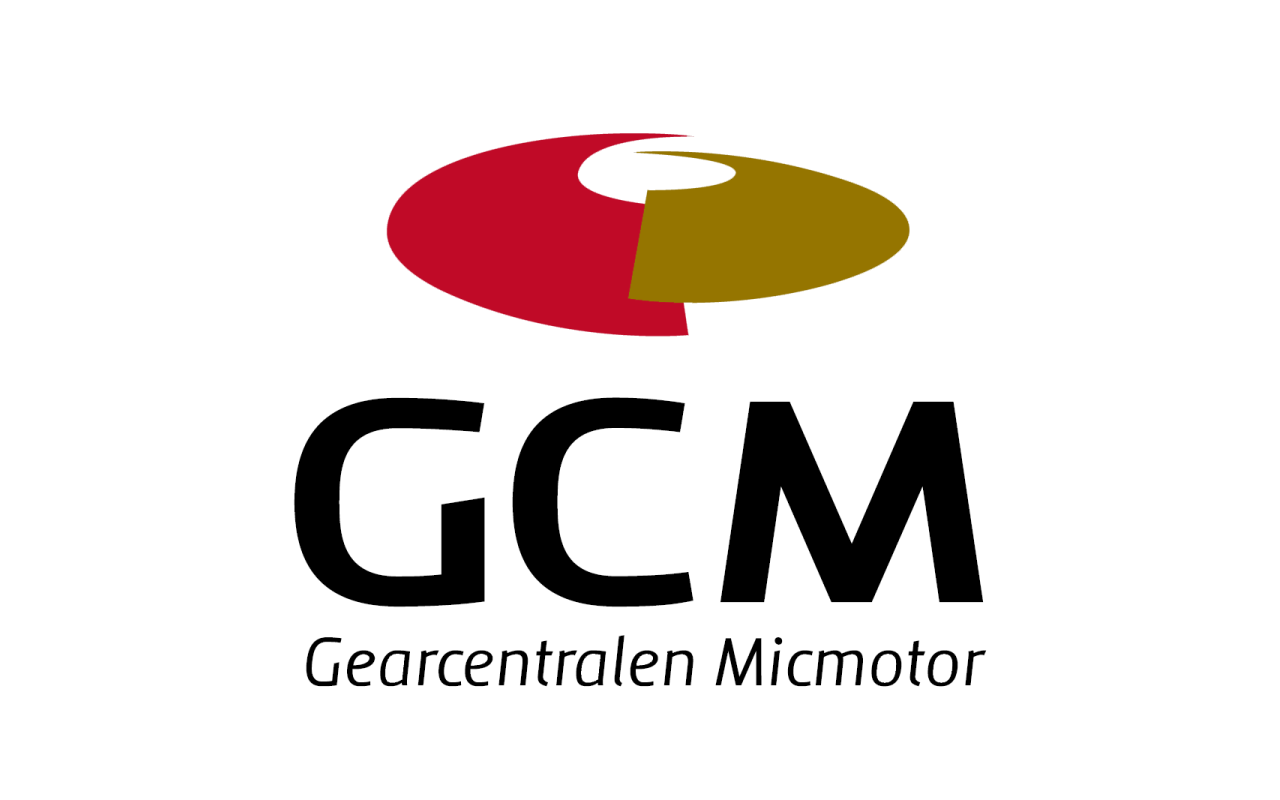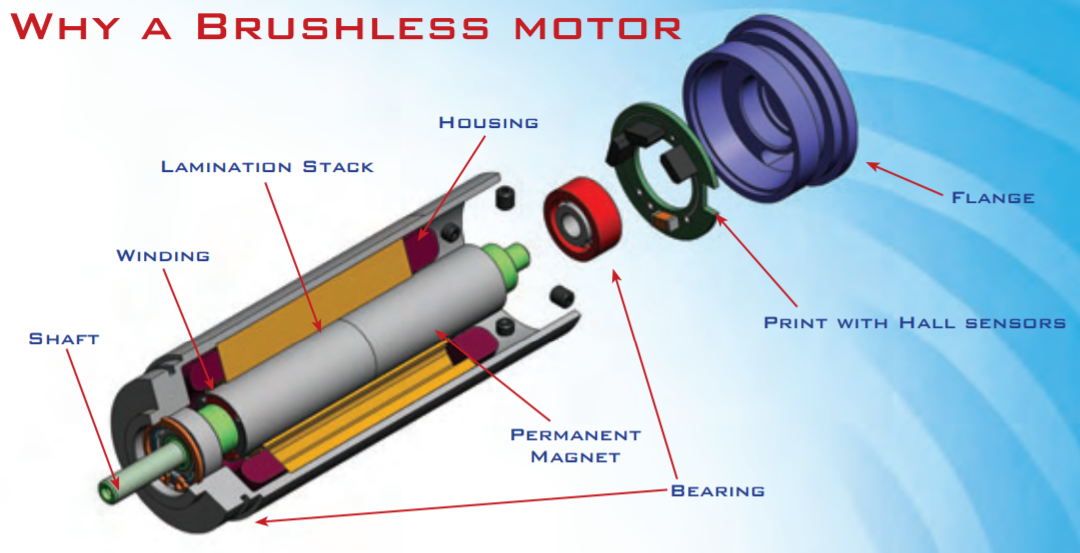Last updated: 9/1/2024
This article provides a basic introduction to brushless DC motors, including the motor’s structure, operation and benefits.
Brushless DC motors (BLDC motors) are high-performing, compact, and versatile electric motors that are ideal for a wide range of applications that require high efficiency, high torque, and high speed.
But how does a brushless motor work and how does it differ from the more conventional DC motors with carbon brushes? And what are the benefits of brushless motors in general? Learn more about how your business can benefit from BLDC motors in this article.
How does a brushless DC motor work?
Conventional DC motors (also known as direct current motors) use a stationary magnet with a rotating armature that achieves automatic rotation via commutation segments and carbon brushes. This motor design is efficient but has some drawbacks, such as wear on the carbon brushes and reduced efficiency.
In contrast, brushless DC motors have an inverted design where the permanent magnet rotates while the windings are part of the stator and can be activated without the use of commutator and carbon brushes. The commutation of the BLDC motor is done electronically and can be done either by looking at the motor’s back electromotive force (back-EMF) or by using hall sensors.
What is the difference between a brushless (BLDC) motor and brush motor?
BLDC motors have a number of advantages over traditional DC motors with carbon brushes. One of the key benefits is that brushless motors have no mechanical commutation.
Traditional DC motors with carbon brushes , on the other hand, are built with the conventional design that uses mechanical commutation, using a rotating armature and carbon brushes to make the electrical connections. The reduced moving part means brushless motors have a long lifespan, limited only by wear and tear on ball bearings.
BLDC Motor Design
The motor torque is an important characteristic of any motor as it determines how much power the motor can generate. The main components involved in generating torque are the magnet, the winding and the flux paths.
The magnet generates a magnetic field that the winding interacts with. This interaction creates an electric current in the winding, which in turn generates a magnetic field. These two magnetic fields interact with each other and create torque.
The copper content in the winding contributes to the motor’s power. The more copper in the winding, the more power the motor can generate. The flux paths guide the magnetic field in the right direction, minimizing losses.
To design a motor with high efficiency, it’s important to optimize on the right parameters. These parameters include magnet strength, winding design and flux path geometry.
One of our many loyal suppliers, Portescap, has developed 3 families of brushless (slotless) motors that are designed to deliver excellent performance. The motors are made with an innovative U-coil that offers a number of benefits, including
- Minimal iron loss: Iron loss is one of the most important factors affecting engine efficiency. The U-coil significantly reduces iron loss, which increases the efficiency of the motor.
- Increased efficiency: The higher efficiency means the motor can generate more power with less energy.
- Lower engine temperature: The lower engine temperature improves the lifespan of the engine.
This coil design is the key to excellent performance, allowing two-pole motors to deliver 30% more torque compared to the same size motors with conventional coil designs.
The motor design therefore has a significant impact on the efficiency of the BLDC motor and depends on how different suppliers optimize the parameters.
Brushless DC motor technology: Slotted & Slotless
Two types of BLDC motors are most commonly offered: slotted and slotless.
Both motor types have permanent magnets that create a magnetic field that the winding interacts with. The main difference between the two types is how the winding is placed in the stator.
Slotted brushless motors have coils inserted into the stator ‘slots’. These slots are small holes in the stator that the coils fit into. These slots give the motor some rigidity, which can be an advantage in some applications.
On the other hand, slots can also create a ‘cogging’ moment. Cogging is an unwanted vibration that occurs when the rotor passes over the aforementioned slots. Cogging can reduce engine efficiency and noise levels.
Slotless brushless motors do not have slots. Instead, the winding is molded into the stator. This eliminates cogging and gives the motor a smoother rotation.
Both types of brushless motors have high efficiency. The exact efficiency depends on the specific design of the motor.
Advantages of brushless DC motors
Brushless DC motors have a number of advantages that make them an attractive choice in various applications.
One of the key benefits of BLDC motors is their long lifespan. Brushless DC motors have no mechanical commutation, which is one of the biggest causes of wear and tear on traditional DC motors.
Instead of mechanical commutation, BLDC motors use an electronic system to control the direction of rotation of the motor. This system is much more durable than mechanical commutation, which is the reason for the longer lifespan of BLDC motors.
Another advantage of brushless DC motors is their high efficiency. BLDC motors can have an efficiency of up to 90%, which is significantly higher than traditional DC motors that typically have an efficiency of 70-80%.
Higher efficiency means brushless DC motors can generate more power with less energy. This can reduce costs and improve the environment.
Brushless DC motors also have a high overload capability and can handle significant loads without damage. This makes them a great choice for applications that require a high level of reliability and performance.
Overall, brushless DC motors are an ideal option for applications that require a reliable, efficient and durable motor.
Applications of BLDC motors
Brushless DC motors are used in a wide range of applications. They are especially popular in medical devices, industrial automation, aerospace, defense, security and access.
Medical equipment
Brushless DC motors are ideal for applications that require precision and reliability. They are often used in surgical instruments, respirators, ventilators, infusion pumps and analyzers.
Industrial automation
BLDC motors are used to power a variety of industrial applications, including torque screwdrivers, air pumps, conveyor belts and electric grippers.
Aerospace and defense
BLDC motors are often used in aircraft instruments, gyroscopes and satellites. The motors are often ideal in aerospace and defense applications that require long life and reliability.
Security and access
The compact size and low operating temperatures of brushless motors make them excellent for use in barcode readers, cameras, locks, ticket printers and dispensers.
Other applications
Other applications for brushless motors include robotics, precision instrumentation and engraving.
You can take a closer look at our brushless DC motors
here
where you will also find data sheets with specifications.
GCM A/S delivers customized motors for your project needs
At GCM, we are a leading supplier of brushless DC motors and we offer a wide range of customized solutions for any application.
We can customize our motors to meet your specific needs, whether you need a motor with a certain size, shape, speed, torque or other characteristics.
Some of the customizations we can offer:
- Special axles: We can supply axles with a variety of lengths, diameters, holes and coatings.
- Special materials: We have motors in a variety of materials, including aluminum, steel and stainless steel.
- Custom windings: We can design windings to meet your specific needs, for example in terms of voltage, speed or torque.
- Special wire terminations: We can supply motors with a variety of different wire terminations, e.g. with plugs or terminal connections.
- Special mounting features: We can develop motors that are easy to mount in your application.
- Alternative laminate and magnet materials: We can use alternative laminate and magnet materials, for example to improve motor performance, lifespan or noise levels.
- Sterilizable: We can offer motors suitable for use in medical applications.
- Encoder: We can supply motors with encoders that allow you to measure the rotational speed or position of the motor.
We work closely with our customers to ensure we deliver the ideal solution for their needs.
Do you have a good idea that we can help you with?
We are always ready for a non-binding dialog about the possibilities of working together on a new development project. From idea to finished product, we can support or even replace your in-house development department.
Contact us today by creating an inquiry in the form below – our engineers are ready to answer your inquiry as soon as possible.
Remember that you are also welcome to call us on tel. 74 42 18 64 during our opening hours.

